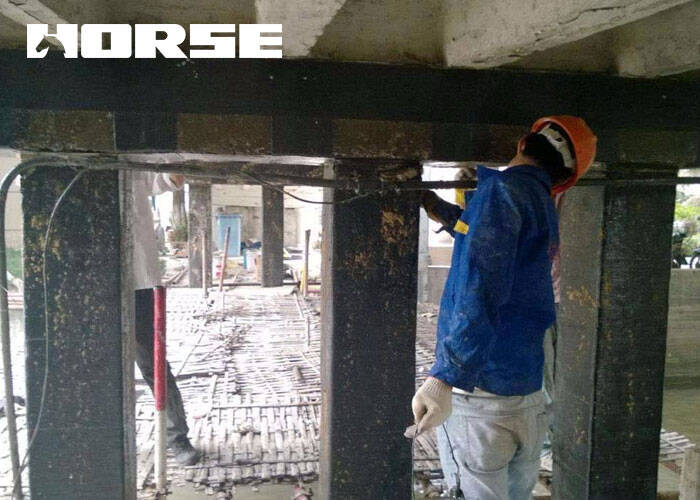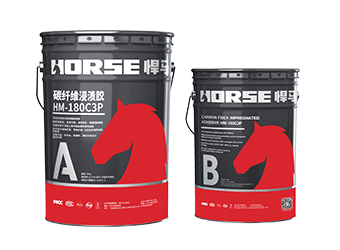Solutions
Horse Construction offers full range of structural strengthening materials with technical supports, documentation supports, products supports, project supports.
unidirectional carbon fiber strengthening bridge

With the continuous development of my country's economy, the requirements for road and railway transportation are getting higher and higher. Among them, bridge technology is a very important link. my country's bridge technology has developed rapidly since the 1980s. However, the development of bridge maintenance, maintenance, repair and reinforcement technology is relatively slow, and the progress is relatively lagging. This is the main technical defect in the development of highway bridges in my country. This article mainly introduces the use of carbon fiber reinforcement technology to make bridge construction more stable.
Carbon fiber reinforced materials and their performance
The use of unidirectional carbon fiber materials in concrete structures to strengthen the reinforcement and repair of building structures is a newly developed technology in recent years. The advantage of this new technology is that it uses impregnated resin to firmly stick the auxiliary component made of carbon fiber material on the damaged component. (Along the force direction of the damaged concrete member, or perpendicular to the force direction of the damaged member). Because of the excellent toughness of carbon fiber materials, it is fully integrated with the components, work together and play a role, thereby effectively strengthening the concrete components.
In bridge reinforcement construction, two materials are usually used, namely carbon fiber composite materials including unidirectional carbon fiber cloth and bonding materials. Let's make a brief introduction below.
unidirectional carbon fiber fabric is currently the most widely used material in bridge strengthening technology. Unidirectional arbon fiber fabric has good elasticity, is not easy to be broken, has high strength, can withstand the huge pressure brought by damaged components, has good toughness, and can effectively compensate for the function of damaged components. At the same time, the strength change between individual fibers is small, and the strength is stable and remains unchanged during manufacturing and processing.
The function of the bonding material is to connect the unidirectional carbon fiber and the damaged concrete member together, which acts as a bond. Therefore, the bonding material is an important key point for whether the carbon fiber and the damaged component can be connected together, and it is also the weak link in the force transmission path between the two. Therefore, the bonding material should have sufficient rigidity, strength and toughness to effectively ensure the transmission of the shear force between the carbon fiber and the damaged concrete component, and it will not cause the brittle bond damage due to the cracking of the concrete component.

The main features of carbon fiber reinforcement
As a new type of high-efficiency bridge reinforcement technology, carbon fiber reinforcement technology has the following characteristics
1 The use of carbon fiber reinforcement is compared with other reinforcement methods. Because of the unique strength and toughness of carbon fiber, the reinforcement technology of carbon fiber will not increase the load-bearing pressure of the component, nor will it further expand the size of the section. Furthermore, the carbon fiber reinforcement technology will not affect the structural appearance of the entire bridge, nor will it reduce the space under the bridge.
2 The construction of carbon fiber reinforcement technology is very simple and the technology is not complicated, so there is no need to use large-scale equipment. The construction period is relatively short, and the construction process can be free of space constraints. When the carbon fiber is connected to the damaged component, because of the flexible characteristics of the carbon fiber cloth itself, the carbon fiber cloth can be connected with any shape of the damaged component to reinforce it and form it very conveniently.
3 When reinforcing the carbon fiber cloth, according to the rigidity and strength of the carbon fiber cloth itself, it is effectively bonded with the damaged concrete member through a bonding material such as epoxy resin, so that there is no need to set additional staggered bolts or gouge the concrete, not damage the original intact components.
4 When the carbon fiber cloth is used for reinforcement, the thousand carbon fiber cloth itself is very flexible. When it is pasted on the surface of the damaged concrete member, it can effectively seal and connect the cracks on the surface of the damaged concrete member. And it can strongly restrain the generation of cracks in concrete structures and prevent the further expansion of cracks.
5 During reinforcement, due to the aging of the damaged component, the carbon fiber cloth may be used more than once, but the carbon fiber cloth can be continuously wound, overlapped, and pasted in the same part, so as to fully meet the reinforcement requirements of the component. Ultimately, the effect of reinforcement will be optimal.

Calculation of carbon fiber reinforcement technology
Although carbon fiber reinforcement technology has many advantages, it cannot be sloppy during construction. It must undergo strict and detailed calculations before construction can be carried out.
1 Although carbon fiber cloth is extremely flexible, it can only bear part of the bearing pressure under the action of live load. Therefore, in the calculation before construction, the stress state of the carbon fiber cloth should be calculated according to the corresponding elastic mode ratio and the ultimate stress method.
2 When reinforcing the carbon fiber cloth, the technician should first assume the cross-section of the damaged component. After the damaged component is bent, its cross-section remains flat. Then during reinforcement, the tensile strain capacity of the pasted carbon fiber cloth material is still determined according to the calculation of the section assumption, but it cannot exceed the allowable tensile strain strength of the carbon fiber cloth material.
3 When reinforcing the carbon fiber cloth, it should be noted that the stress of the steel bar is equal to the product of the steel bar strain and its elastic modulus, but not less than the designed strength value. Otherwise, although the carbon fiber cloth has good flexibility, it cannot withstand huge pressure.
4 Before reaching the ultimate state of flexural bearing capacity, the carbon fiber sheet and the concrete must be reliably bonded, and no bond peeling failure occurs.
5 There are many failure modes of reinforced concrete structures with carbon fiber sheets, and the correlation with the tensile steel bars is relatively large. The ultimate state of the reinforced members needs to be determined.
Conclusion
At present, my country's bridge construction technology has entered the world's leading level, but unfortunately, my country is not very concerned about bridge maintenance. I thought that by building a bridge, I could get it done once and for all, but I didn't know that this idea was so wrong. Bridges also have their service life and will age. When the bridge is damaged, if it cannot be reinforced in time, it will accelerate the aging of the bridge. Therefore, we should pay attention to bridge reinforcement technology.
Therefore, we must realize the importance of carbon fiber reinforcement technology for bridge reinforcement as soon as possible. With the continuous in-depth research and further development of carbon fiber repair and reinforcement technology, this advanced technology will be widely accepted and adopted by the engineering community. Really and effectively improve the traffic load and safety performance of the bridge, and serve our highway engineering construction
You can find anything here you are in need of, have a trust trying on these products, you will find the big difference after that.

Good impregnation carbon fiber adhesive for applying carbon fiber reinforced polymer(CFRP) wrap for structural strengthening

High strength carbon fiber reinforced polymer (CFRP) strip / laminate / plate for structural strengthening and concrete repair

High strength, unidirectional carbon fiber sheet pre-saturated to form a carbon fiber reinforced polymer (CFRP) sheet used to strengthen structural concrete elements.